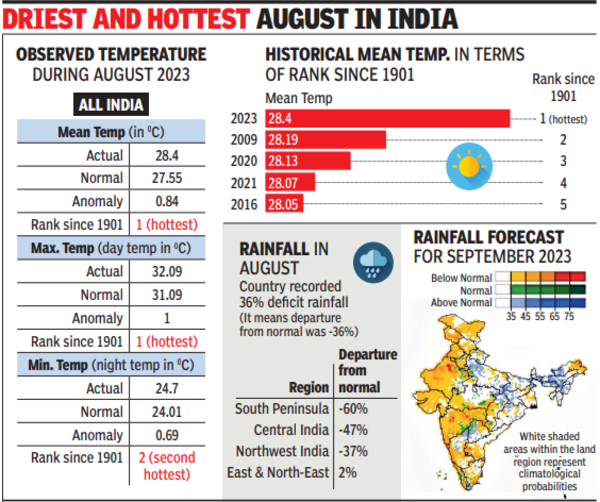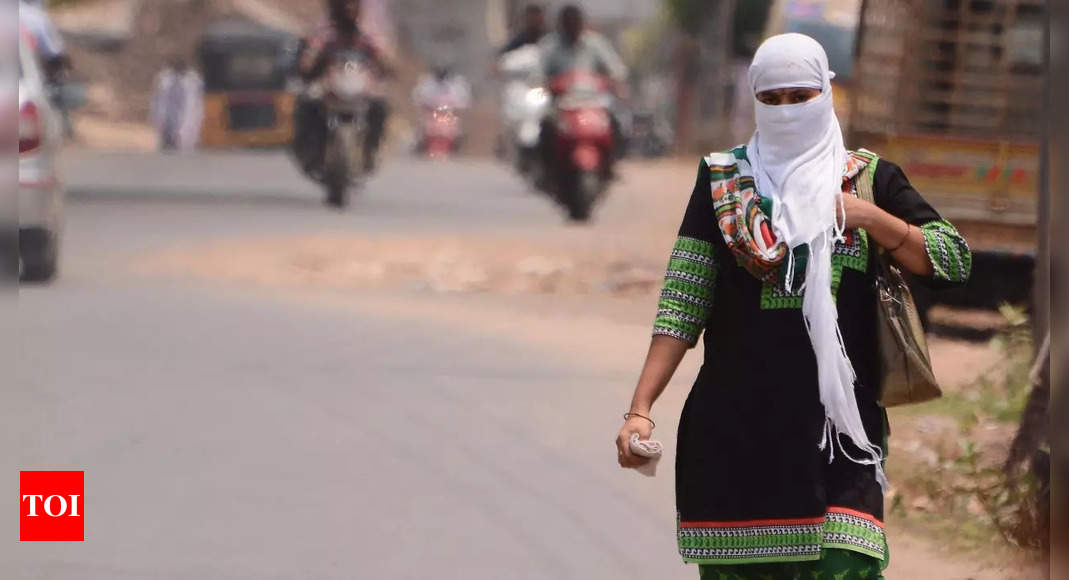NEW DELHI: August was not just the driest month since 1901 but it was also the hottest ever recorded in India, said the India Meteorological Department (IMD) on Thursday while sharing that four out of five hottest August mean temperatures were recorded in the last seven years, an indication of growing extreme weather events due to climate change.
A bit of relief is, however, expected in September as the monsoon rainfallactivity in the month is going to be ‘normal’ in the country as a whole.But the overall seasonal (June-Sept) rainfall is likely to be ‘below normal’ due to the huge deficit (36%) in August. “Overall, themonsoon season (June-Sept) in the country as a whole is not going to be deficient,” said IMD chief M Mohapatra.
IMD chief M Mohapatra on Thursday indicated that the total deficit at the end of the four-month season may not exceed 10%. It means 2023 will not end as a drought year like 2014 and 2015 even as the cumulative monsoon rainfall (June 1-August 31) has already reached a deficit of 10% as on Thursday. The IMD’s records show that the country recorded the highest-ever mean temperature in August (since 1901 when scientific record keeping of weather parameters started) with 28.4 degrees Celsius which was 0.84 degree C higher than normal mean temperature. The month also recorded the highest average day (maximum) temperature and second highest night (minimum) temperature since 1901.

Region-wise, the south Peninsula recorded its highest-ever August mean temperature (28.95 degree C) with both average day (32.65 degree C) and night (25.26 degree C) temperatures too being the highest since 1901.
“Normal to above normal rainfall is most likely over many areas of northeast India, adjoining east India, foothills of Himalayas and some areas of east-central and south peninsular area. Below normal rainfall probability is, however, most likely over most areas of the remaining part of the country,” said the IMD chief.
It means even northwest India, including Delhi-NCR region and Rajasthan, Gujarat and Maharashtra are likely to get ‘below normal’ rainfall. So far, east Uttar Pradesh, Bihar, Jharkhand, Chhattisgarh, Gangetic West Bengal, Kerala, south interior Karnataka, Rayalaseema, Madhya Maharashtra and Marathwada had deficient rainfall. It has, however, not impacted the overall acreage of kharif crops, including even the water-guzzling paddy.
The agriculture ministry’s sown area data, released last Friday, shows not only an increase in paddy acreage by over 4% compared to last year but also marginal increase of acreage of all kharif (summer sown) crops put together despite the monsoon rainfall deficit.
Though the acreage of paddy (384 lakh hectares) as on last Friday was 4% less than its normal sown area (average of last five years) of the sowing season, farmers at least could manage to increase its acreage over last year’s corresponding sown area by using groundwater and other sources of irrigation, including the network of minor irrigation infrastructure.
A bit of relief is, however, expected in September as the monsoon rainfallactivity in the month is going to be ‘normal’ in the country as a whole.But the overall seasonal (June-Sept) rainfall is likely to be ‘below normal’ due to the huge deficit (36%) in August. “Overall, themonsoon season (June-Sept) in the country as a whole is not going to be deficient,” said IMD chief M Mohapatra.
IMD chief M Mohapatra on Thursday indicated that the total deficit at the end of the four-month season may not exceed 10%. It means 2023 will not end as a drought year like 2014 and 2015 even as the cumulative monsoon rainfall (June 1-August 31) has already reached a deficit of 10% as on Thursday. The IMD’s records show that the country recorded the highest-ever mean temperature in August (since 1901 when scientific record keeping of weather parameters started) with 28.4 degrees Celsius which was 0.84 degree C higher than normal mean temperature. The month also recorded the highest average day (maximum) temperature and second highest night (minimum) temperature since 1901.

Region-wise, the south Peninsula recorded its highest-ever August mean temperature (28.95 degree C) with both average day (32.65 degree C) and night (25.26 degree C) temperatures too being the highest since 1901.
Releasing IMD’s monthly rainfall and temperature outlook for September, Mohapatra said the rainfall over the country as a whole during September is likely to be ‘normal’ (91-109% of the long period average — 167.9 mm).
“Normal to above normal rainfall is most likely over many areas of northeast India, adjoining east India, foothills of Himalayas and some areas of east-central and south peninsular area. Below normal rainfall probability is, however, most likely over most areas of the remaining part of the country,” said the IMD chief.
It means even northwest India, including Delhi-NCR region and Rajasthan, Gujarat and Maharashtra are likely to get ‘below normal’ rainfall. So far, east Uttar Pradesh, Bihar, Jharkhand, Chhattisgarh, Gangetic West Bengal, Kerala, south interior Karnataka, Rayalaseema, Madhya Maharashtra and Marathwada had deficient rainfall. It has, however, not impacted the overall acreage of kharif crops, including even the water-guzzling paddy.
The agriculture ministry’s sown area data, released last Friday, shows not only an increase in paddy acreage by over 4% compared to last year but also marginal increase of acreage of all kharif (summer sown) crops put together despite the monsoon rainfall deficit.
Though the acreage of paddy (384 lakh hectares) as on last Friday was 4% less than its normal sown area (average of last five years) of the sowing season, farmers at least could manage to increase its acreage over last year’s corresponding sown area by using groundwater and other sources of irrigation, including the network of minor irrigation infrastructure.
Source link

